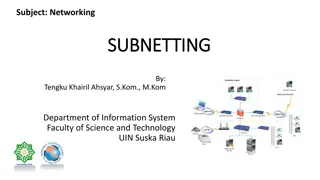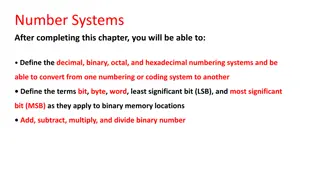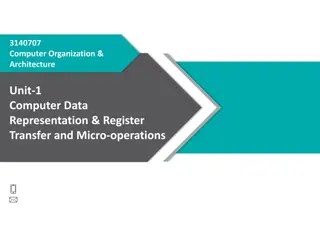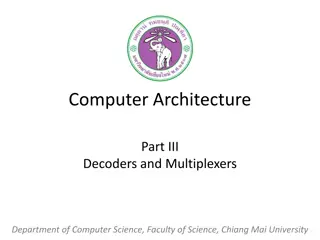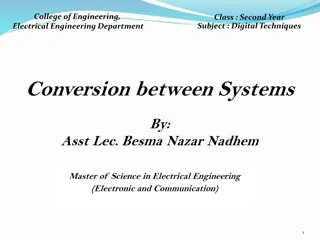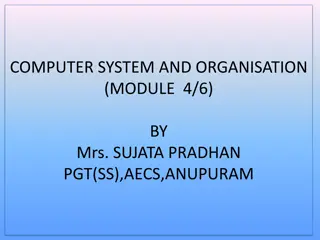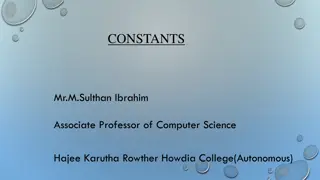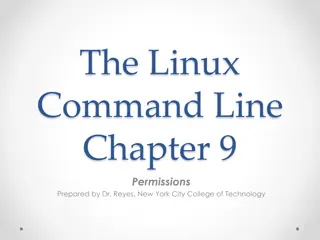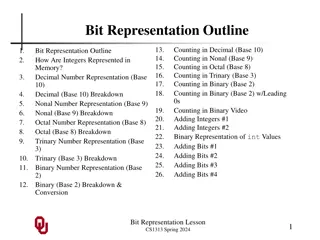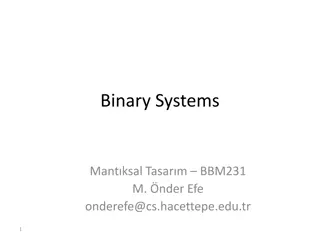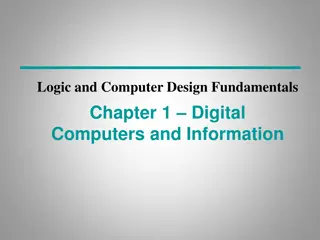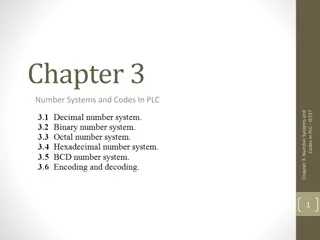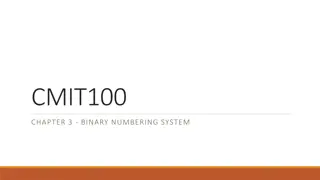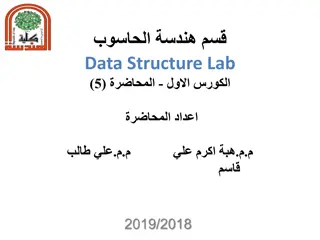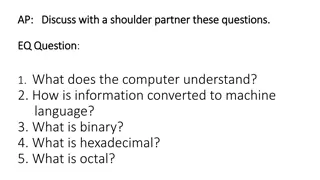Mastering Subnetting: A Comprehensive Overview
Delve into the world of subnetting with Tengku Khairil Ahsyar's course outline covering IP address conversion, subnet mask calculation, and more. Learn about binary, octal, decimal, and hexadecimal number systems along with conversion techniques. Understand the significance of subnetting for efficie
1 views • 25 slides
Understanding Number Systems in Digital Computing
Explore the decimal, binary, octal, and hexadecimal numbering systems essential for digital computing. Learn to convert between these systems, grasp terms like bit, byte, and word, and perform basic binary arithmetic operations. Visual aids and explanations make complex concepts easily understandabl
0 views • 24 slides
Comprehensive Overview of Computer Data Representation and Operations
Delve into the intricate world of computer data representation and micro-operations, covering topics such as binary, octal, and hexadecimal number systems, complements, fixed-point and floating-point representations, arithmetic and logic micro-operations, register transfer language, and more.
1 views • 70 slides
Understanding Decoders and Multiplexers in Computer Architecture
Decoders and multiplexers are essential components in computer architecture, converting binary information efficiently. Integrated circuits house digital gates, enabling the functioning of these circuits. A decoder's purpose is to generate binary combinations, with examples like the 3-to-8-line deco
0 views • 37 slides
Digital Techniques for Number System Conversion in Electrical Engineering
Understand how to convert between binary, octal, decimal, and hexadecimal number systems with examples and explanations. Learn the processes of binary-to-decimal, octal-to-decimal, hexadecimal-to-decimal, decimal-to-binary, decimal-to-octal, and decimal-to-hexadecimal conversions. Gain insights into
0 views • 10 slides
Understanding Number Systems and Conversions in Computer Systems
Explore the fundamentals of number systems in computer science, including decimal, binary, octal, and hexadecimal. Learn conversion methods between different bases and practical examples like converting decimal to binary. Dive into octal-binary conversions with solved problems. Enhance your knowledg
1 views • 16 slides
Understanding Different Types of Constants in Programming
Constants in programming are fixed values that do not change during program execution. They include character, numerical, and string constants. Integer constants can be decimal, octal, or hexadecimal. This article explains each type of constant with examples of decimal, octal, and hexadecimal intege
0 views • 22 slides
Understanding File Permissions and Ownership in Linux
This content discusses the concept of file permissions and ownership in Linux, covering the three levels of ownership (owner, group, everybody), the usage of the 'ls -l' and 'id' commands to check identity information, changing file permissions using the 'chmod' command with octal notation, and meth
0 views • 5 slides
Understanding Integer Representation in Computer Memory
Explore the binary representation of integers in computer memory, covering decimal, nonal, octal, trinary, and binary numbering systems. Learn how integers are stored using sequences of bits and decipher the breakdown of numbers in different bases. Discover the Arabic digits in decimal representatio
0 views • 26 slides
Understanding Binary and Numeric Systems in Computing
Delve into the world of binary systems, binary numbers, base conversions, powers of 2, arithmetic operations with binary and octal numbers, and multiplication principles in computing. Learn how to compute values and conversions in various number systems efficiently.
0 views • 41 slides
Digital Computers and Information Representation Fundamentals
Explore the basics of digital systems, number systems, arithmetic operations, and information representation in computers. Dive into binary, octal, and hexadecimal systems, along with signal processing and number system examples. Gain insights into computer organization and assembly language, utiliz
0 views • 28 slides
Understanding Number Systems and Codes in PLC
Delve into the world of number systems and codes in Programmable Logic Controllers (PLC) with a focus on decimal, binary, octal, and hexadecimal systems. Learn how data is represented and manipulated in PLC applications through various numeric systems and codes. Explore the significance of bits, byt
0 views • 12 slides
Understanding Binary Numbering Systems and Character Representation in Computing
Explore the world of numbering systems including decimal, binary, octal, and hexadecimal, and delve into how characters are stored in computer memory. Learn about Boolean operations and their application on binary numbers, with a focus on IP addresses. Discover the importance of ASCII, Unicode, and
0 views • 26 slides
Understanding Constants and Literals in C++ Programming
Constants and literals in C++ are fixed values that the program cannot alter. They come in various types such as integer numerals, floating-point numerals, characters, strings, and boolean values. Integer literals can be decimal, octal, or hexadecimal constants, while floating-point literals have in
0 views • 7 slides
Understanding Data Handling in Python
Types of data in Python include Number, String, List, Tuple, Set, and Dictionary. Python supports integers, floating point numbers, and complex numbers with the classes int, float, and complex. Different number systems like binary, hexadecimal, and octal are also supported. Type conversion in Python
0 views • 49 slides
Understanding Binary Numbers and Computer Data Representation
A computer stores information digitally as binary numbers, where data is broken down into pieces and represented as numbers. The binary system uses 0s and 1s to encode information, with each bit representing on/off states. This system is crucial for converting data into machine language. Binary numb
0 views • 14 slides
